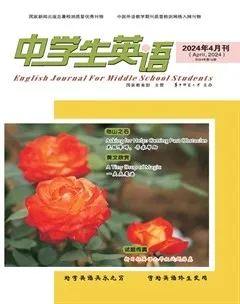Magpies Teach Scientists an Unexpected Lesson喜鹊给科学家上了意想不到的一课
Science experiments don’t always go as planned, butthat doesn’t mean you can’t learn from them. Recently,Australian scientists learned something unexpected aboutmagpies when they tried to attach2 trackers3 to them to learn more abouttheir habits.
科学实验并不总是按计划进行的,但这并不意味着你不能从中学到东西。最近,澳大利亚科学家在给喜鹊戴上追踪器以了解它们的习性时,发现了一些意想不到的情况。
The birds the scientists aimed to study were Australian magpies. They’remedium-sized black and white birds from the same bird “family”as crows andbluejays. They are known to be quite clever. They live in groups of up to 12birds and work together to protect the area they live in.
科学家们研究的鸟类目标是澳大利亚喜鹊。它们是中等大小的黑白色鸟类,与乌鸦和冠蓝鸦属于同一“家族”。人们都知道它们很聪明。它们会12 只左右为一群,共同保卫它们生活的地区。
The researchers want to try a new tracker on the magpies. They hoped tolearn more about how far the birds flew and what they did during a normal day.The scientists are worried that magpies may have a hard time adjusting4 as theworld warms up because of climate change.
研究人员想在喜鹊身上试验一种新的追踪器。他们希望更多地了解这些鸟飞了多远,以及它们在平常的一天里做了什么。科学家们担心喜鹊可能很难适应气候变化导致的全球变暖。
It’s hard to find trackers that work well with small and medium-sizedbirds. Either the trackers are too heavy, or don’t last long enough. The newtrackers were light and could be recharged5 without wires6 while they were stillon the birds.
找到适合中小型鸟类的追踪器很困难。追踪器要么太重,要么续航时间不够长。新型的追踪器很轻,而且安装在鸟身上时可以不用电线充电。
To keep the trackers on the birds without causing flying problems, theresearchers developed a special harness7. It had a special release controlledby magnets8. This was meant to allow the scientists to free the birds fromthe harnesses at a special magnetic bird feeder, without having to catch thebirds again.
为了让追踪器在不影响鸟类飞行的情况下跟踪鸟类,研究人员开发了一种特殊的背带。它有一个由磁铁控制的特殊释放装置。这样做的目的是为了让科学家们在一个特殊的有磁性的喂鸟器上把鸟儿从束带中解放出来,而无需再次捕捉鸟儿。
There was just one problem—the birds didn’t like the trackers.
只有一个问题———鸟儿不喜欢追踪器。
The researchers placed trackers on five magpies using their special harnesses.But just ten minutes after setting up the last magpie, they noticed something unusual:an adult female magpie was helping another magpie get free from its harness.
研究人员使用特殊的背带给五只喜鹊戴上了追踪器。但就在安置完最后一只喜鹊十分钟后,他们注意到一件不寻常的事:一只成年雌喜鹊正在帮助另一只喜鹊挣脱背带。
In a few hours, most of the other magpies had also been freed from theirharnesses. By the third day, none of the birds had trackers anymore. “The birds aresmarter than us,”said one of the scientists.
几个小时后,其他大多数喜鹊也挣脱了背带。到了第三天,所有的鸟儿身上都没有追踪器了。“鸟类比我们聪明。”其中一名科学家说。
The scientists were disappointed about the trackers, but they realized that themagpies had taught them something else: that magpies are able and willing to helpeach other out, even if the bird who is helping doesn’t get a reward.
科学家们对这些追踪器感到失望,但他们意识到喜鹊教会了他们别的东西:喜鹊有能力也愿意互相帮助,即使帮助的鸟得不到奖励。
This is called “rescue9 behavior”, and it’s not that common in the animalworld, especially among birds. The researchers think this is the first time rescuebehavior has been reported for Australian magpies.
这被称为“救援行为”,在动物世界中,尤其是在鸟类中并不常见。研究人员认为,这是关于澳大利亚喜鹊救援行为的首次报告。
The scientists think the birds might have thought the trackers wereparasites. They don’t know how the magpies solved the difficult problem ofgetting the harness off. They also don’t know if it was just one magpie or severalwho removed the harnesses.
科学家们认为鸟类可能以为这些追踪器是寄生虫。他们不知道喜鹊是如何解决挣脱背带这一难题的。他们也不知道卸下了背带的是一只喜鹊还是几只喜鹊。
The researchers are glad they’ve learned about the rescue behavior ofmagpies. But now they need to try again to figure out a good way to track theseclever birds.
研究人员很高兴他们了解了喜鹊的救援行为。但现在他们需要再次尝试找到一种追踪这些聪明鸟类的好方法。
(英语原文选自:kidsnews.com.au)

